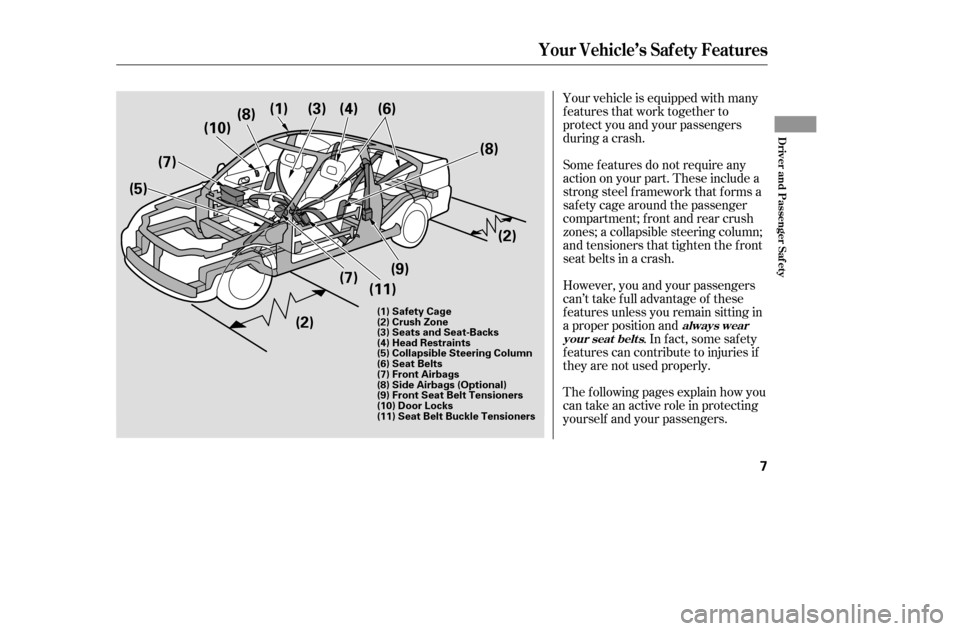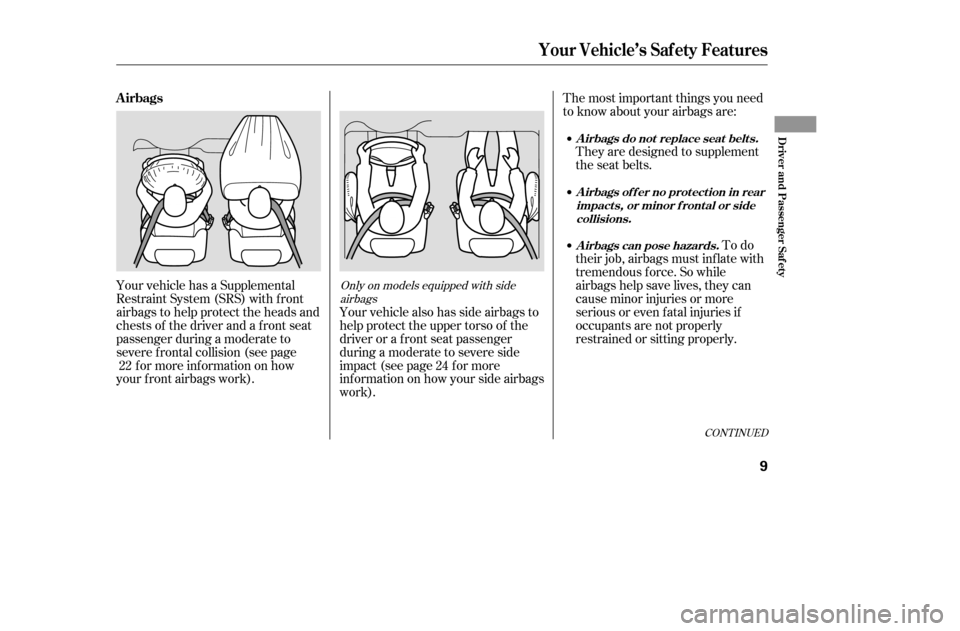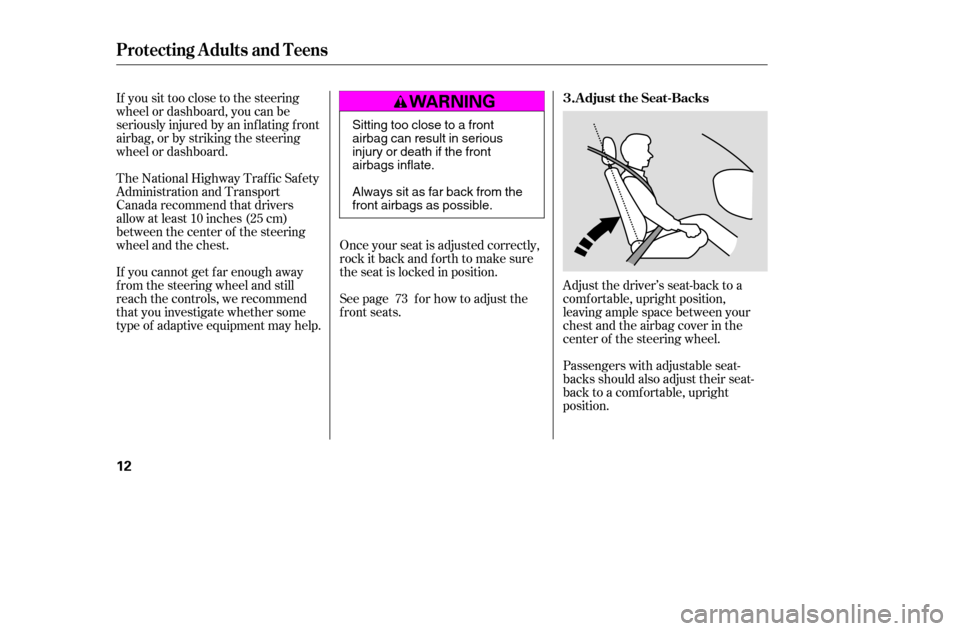Page 1 of 226
Your Vehicle at a Glance
Your Vehicle at a Glance
3
POWER WINDOW
SWITCHESHOOD RELEASE
HANDLE HEATING/COOLING CONTROLS
A/T model is shown. AUTOMATIC TRANSMISSION
MANUAL TRANSMISSION
GAUGES
POWER
DOOR LOCK
MASTER
SWITCH INSTRUMENT PANEL INDICATORS (P. 51)
(P. 58) (P.9,22)FRONT AIRBAGS
(P. 69)
(P. 78)
FUEL FILL DOOR RELEASE
HANDLE
(P. 123)
TRUNK RELEASE HANDLE
(P. 70) (P. 124)(P. 138)
(P. 136) (P. 88)
�����—�����—�����y�
���������
���y���
�(���%�������y���������y
Page 3 of 226

�µ
You’ll f ind many saf ety
recommendations throughout this
section, and throughout this manual.
Therecommendationsonthispage
are the ones we consider to be the
most important.
A seat belt is your best protection in
all types of collisions. Airbags are
designed to supplement seat belts,
not replace them. So even though
your vehicle is equipped with airbags,
make sure you and your passengers
always wear your seat belts, and
wear them properly (see page ).
Alcohol and driving don’t mix. Even
one drink can reduce your ability to
respond to changing conditions, and
your reaction time gets worse withevery additional drink. So don’t drink
and drive, and don’t let your f riends
drink and drive, either.
While airbags can save lives, they
can cause serious or fatal injuries to
occupants who sit too close to them,
or are not properly restrained.
Inf ants, young children, and short
adults are at the greatest risk. Be
sure to f ollow all instructions and
warnings in this manual.
Children age 12 and under should
ride properly restrained in a back
seat, not the front seat. Infants and
smallchildrenshouldberestrained
in a child seat. Larger children
should use a booster seat and a lap/
shoulder belt until they can use the
belt properly without a booster seat
(see pages ).
Excessive speed is a major f actor in
crash injuries and deaths. Generally,
the higher the speed, the greater the
risk, but serious injuries can also
occur at lower speeds. Never drive
f aster than is saf e f or current
conditions, regardless of the
maximum speed posted.
Having a tire blowout or a
mechanical f ailure can be extremely
hazardous. To reduce the possibility
of such problems, check your tire
pressures and condition f requently,
and perform all regularly scheduled
maintenance (see page ).
14
44
27
152
Important Saf ety Precautions
Always Wear Your Seat Belt
Don’t Drink and Drive
Be Aware of Airbag Hazards
Restrain All Children
Control Your Speed
K eep Your Vehicle in Saf e
Condition
6
�����—�����—�����y�
�������������y���
�(���%�������y���������y
Page 4 of 226

Your vehicle is equipped with many
features that work together to
protect you and your passengers
during a crash.
Some f eatures do not require any
action on your part. These include a
strong steel f ramework that f orms a
saf ety cage around the passenger
compartment; front and rear crush
zones; a collapsible steering column;
and tensioners that tighten the f ront
seat belts in a crash.
However, you and your passengers
can’t take f ull advantage of these
f eatures unless you remain sitting in
a proper position and. In fact, some safety
f eatures can contribute to injuries if
they are not used properly.
The f ollowing pages explain how you
cantakeanactiveroleinprotecting
yourself and your passengers.
Your Vehicle’s Saf ety Features
always wear
your seat belt s
Driver and Passenger Saf ety
7
(7) (11)(9) (2)
(8)
(6)
(4)
(3)
(1)
(7)
(5)
(2)
(10)
(8)
(1) Safety Cage
(2) Crush Zone
(3) Seats and Seat-Backs
(4) Head Restraints
(5) Collapsible Steering Column
(6) Seat Belts
(7) Front Airbags
(8) Side Airbags (Optional)
(9) Front Seat Belt Tensioners
(10) Door Locks
(11) Seat Belt Buckle Tensioners
�����—�����—�����y�
�������������y���
�(���%�������y�����
���y
Page 5 of 226

Your vehicle is equipped with seat
belts in all seating positions.
Your seat belt system also includes
an indicator on the instrument panel
to remind you and your passengers
to f asten your seat belts.
Seat belts are the single most
effectivesafetydeviceforadultsand
larger children. (Inf ants and smaller
children must be properly restrained
in child seats.)
Not wearing a seat belt properly
increases the chance of serious
injury or death in a crash, even
though your vehicle has airbags.
In addition, most states and all
Canadian provinces require you to
wear seat belts.When properly worn, seat belts:
Keep you connected to the vehicle
so you can take advantage of the
vehicle’s built-in saf ety f eatures.
Help protect you in almost every
type of crash, including f rontal,
side, and rear impacts and
rollovers. Help keep you f rom being thrown
against the inside of the vehicle
and against other occupants.
Keep you f rom being thrown out
of the vehicle.
Help keep you in a good position
should the airbags ever deploy. A
good position reduces the risk of
injury f rom an inf lating airbag and
allows you to get the best
advantage f rom the airbag.
Of course, seat belts cannot
completely protect you in every
crash.Butinmostcases,seatbelts
can reduce your risk of serious
injury.
Always wear your seat belt, and
make sure you wear it properly.
Your Vehicle’s Saf ety Features
Seat Belts
Why Wear Seat Belt s
What You Should Do:
8
Not wearing a seat belt properly
increases the chance of serious
injury or death in a crash, even
though your vehicle has airbags.
Be sure you and your
passengers always wear seat
belts and wear them properly.
�����—�����—�����y�
�������������y���
�(���%�������y�����
�
�y
Page 6 of 226

Your vehicle has a Supplemental
Restraint System (SRS) with f ront
airbags to help protect the heads and
chests of the driver and a front seat
passenger during a moderate to
severe f rontal collision (see pagef or more inf ormation on how
your f ront airbags work). Your vehicle also has side airbags to
help protect the upper torso of the
driver or a f ront seat passenger
during a moderate to severe side
impact (see page f or more
information on how your side airbags
work). They are designed to supplement
the seat belts.
The most important things you need
to know about your airbags are:
To do
their job, airbags must inf late with
tremendous f orce. So while
airbags help save lives, they can
cause minor injuries or more
serious or even fatal injuries if
occupants are not properly
restrained or sitting properly.
22 24Only on models equipped with side
airbags
CONT INUED
Airbags do not replace seat belts.
A irbags of f er no prot ect ion in rearimpact s, or minor f ront al or side
collisions.
A irbags can pose hazards.
Airbags
Your Vehicle’s Saf ety Features
Driver and Passenger Saf ety
9
�����—�����—�����y�
���������
�
�y���
�(���%�������y�����
���y
Page 7 of 226
Always wear
your seat belt properly, and sit
upright and as f ar back f rom the
steering wheel as possible while
allowing f ull control of the vehicle. A
f ront passenger should move their
seat as far back from the dashboard
as possible. The rest of this section gives more
detailed inf ormation about how you
can maximize your saf ety.
Remember, however, that no saf ety
system can prevent all injuries or
deaths that can occur in a severe
crash, even when seat belts are
properly worn and the airbags deploy.
Your Vehicle’s Saf ety Features
What you should do:
10
�����—�����—�����y�
���������
���y���
�(���%�������y�����
���y
Page 9 of 226

If you sit too close to the steering
wheel or dashboard, you can be
seriously injured by an inf lating f ront
airbag, or by striking the steering
wheel or dashboard.
The National Highway Traffic Safety
Administration and Transport
Canada recommend that drivers
allow at least 10 inches (25 cm)
between the center of the steering
wheel and the chest.
If you cannot get f ar enough away
f rom the steering wheel and still
reach the controls, we recommend
that you investigate whether some
type of adaptive equipment may help.Once your seat is adjusted correctly,
rock it back and f orth to make sure
the seat is locked in position.
See page f or how to adjust the
f ront seats.
Adjust the driver’s seat-back to a
comf ortable, upright position,
leaving ample space between your
chest and the airbag cover in the
center of the steering wheel.
Passengers with adjustable seat-
backs should also adjust their seat-
back to a comf ortable, upright
position.
73
Protecting A dults and Teens
Adjust the Seat-Backs
3.
12
Sitting too close to a front
airbag can result in serious
injury or death if the front
airbags inflate.
Always sit as far back from the
front airbags as possible.
�����—�����—�����y�
�������������y���
�(���%�������y�����
���y
Page 12 of 226

After all occupants have adjusted
their seats and put on seat belts, it is
very important that they continue to
sit upright, well back in their seats,
with their feet on the floor, until the
vehicle is parked and the engine is
off.
Sitting improperly can increase the
chance of injury during a crash. For
example, if an occupant slouches,
lies down, turns sideways, sits
forward, leans forward or sideways,
or puts one or both f eet up, the
chance of injury during a crash is
greatly increased.In addition, an occupant who is out of
position in the f ront seat can be
seriously or f atally injured in a crash
by striking interior parts of the
vehicle or being struck by an
inflating front airbag.
See page f or additional
inf ormation about your seat belts
and how to take care of them. This could cause
very serious injuries in a crash.
If a seat belt does not seem to work
properly, it may not protect the
occupant in a crash.
Using a seat
belt that is not working properly can
result in serious injury or death.
Have your dealer check the belt as
soon as possible.
18
Protecting A dults and Teens
Maintain a Proper Sitting
Position
6.Never place t he shoulder port ion of a
lap/shoulder belt under your arm orbehind your back.
No one should sit in a seat wit h aninoperat ive seat belt .
Driver and Passenger Saf ety
15
Sitting improperly or out of
position can result in serious
injury or death in a crash.
Always sit upright, well back in
the seat, with your feet on thefloor.
�����—�����—�����y�
�������������y���
�(���%�������y�����
���y